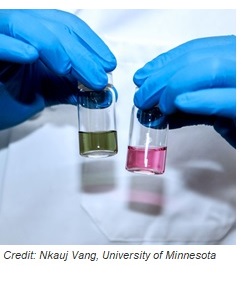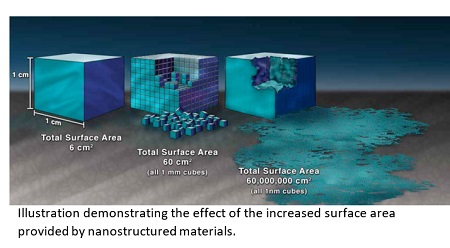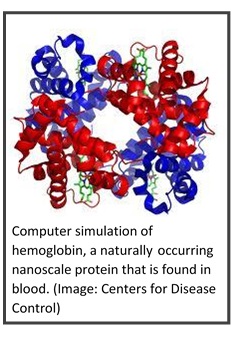Nanotechnology is not simply working at ever-smaller dimensions; rather, working at the nanoscale enables scientists to understand and utilize the unique physical, chemical, mechanical, and optical properties of materials that occur at this scale.
Scale at which quantum effects dominate
 When particles are created with dimensions of about 1–100 nanometers, the materials’ properties can change significantly from those at larger scales. This is the size scale where quantum effects can rule the behavior and properties of particles. A fascinating and powerful result of the quantum effects of the nanoscale is the concept of “tunability” of properties. That is, by changing the size of the particle, a scientist can literally fine-tune a material property of interest. At the nanoscale, properties such as melting point, fluorescence, electrical conductivity, magnetic permeability, and chemical reactivity can change as a function of the size of the particle.
When particles are created with dimensions of about 1–100 nanometers, the materials’ properties can change significantly from those at larger scales. This is the size scale where quantum effects can rule the behavior and properties of particles. A fascinating and powerful result of the quantum effects of the nanoscale is the concept of “tunability” of properties. That is, by changing the size of the particle, a scientist can literally fine-tune a material property of interest. At the nanoscale, properties such as melting point, fluorescence, electrical conductivity, magnetic permeability, and chemical reactivity can change as a function of the size of the particle.
Nanoscale gold illustrates the unique properties that occur at the nanoscale. Nanoscale gold can appear red or purple depending on the size of the particle. Gold nanoparticles interact differently with light compared to larger-scale gold particles due to quantum effects.
Scale at which surface behavior plays a larger role
Nanoscale materials have far larger surface area-to-volume ratio than bulk materials. As surface area per volume increases, materials can become more reactive.
 A simple thought experiment shows why nanoparticles have phenomenally high surface areas. A solid cube of a material 1 cm on a side has 6 square centimeters of surface area, about equal to one side of half a stick of gum. But if that volume of 1 cubic centimeter were filled with cubes 1 mm on a side, that would be 1,000 millimeter-sized cubes (10 x 10 x 10), each one of which has a surface area of 6 square millimeters, for a total surface area of 60 square centimeters—slightly larger than a credit card. When the 1 cubic centimeter is filled with micrometer-sized cubes—a trillion (1012) of them, each with a surface area of 6 square micrometers—the total surface area amounts to 6 square meters, or somewhat smaller than the footprint of a small car. And when that single cubic centimeter of volume is filled with 1-nanometer-sized cubes—1021 of them, each with an area of 6 square nanometers—their total surface area comes to 6,000 square meters. In other words, a single cubic centimeter of cubic nanoparticles has a total surface area that is even bigger than the area of a football field! Because of this higher surface area, more of the material is exposed to the surrounding environment, which can greatly speed chemical reactions of these materials, or reactivity. One benefit of greater surface area—and improved reactivity—in nanostructured materials is that they have helped create better catalysts. An everyday example of catalysis is the catalytic converter in a car, which cleans the exhaust and reduces air pollution. The higher surface area of nanoscale catalysts have enabled modern catalytic converters to use far less precious metal in the catalytic converter than was previously needed to achieve the same reductions in polluting gases. Engineers are taking advantage of the increased reactivity at the nanoscale to design better batteries, fuel cells, and catalysts for cleaner and safer energy generation and storage systems.
A simple thought experiment shows why nanoparticles have phenomenally high surface areas. A solid cube of a material 1 cm on a side has 6 square centimeters of surface area, about equal to one side of half a stick of gum. But if that volume of 1 cubic centimeter were filled with cubes 1 mm on a side, that would be 1,000 millimeter-sized cubes (10 x 10 x 10), each one of which has a surface area of 6 square millimeters, for a total surface area of 60 square centimeters—slightly larger than a credit card. When the 1 cubic centimeter is filled with micrometer-sized cubes—a trillion (1012) of them, each with a surface area of 6 square micrometers—the total surface area amounts to 6 square meters, or somewhat smaller than the footprint of a small car. And when that single cubic centimeter of volume is filled with 1-nanometer-sized cubes—1021 of them, each with an area of 6 square nanometers—their total surface area comes to 6,000 square meters. In other words, a single cubic centimeter of cubic nanoparticles has a total surface area that is even bigger than the area of a football field! Because of this higher surface area, more of the material is exposed to the surrounding environment, which can greatly speed chemical reactions of these materials, or reactivity. One benefit of greater surface area—and improved reactivity—in nanostructured materials is that they have helped create better catalysts. An everyday example of catalysis is the catalytic converter in a car, which cleans the exhaust and reduces air pollution. The higher surface area of nanoscale catalysts have enabled modern catalytic converters to use far less precious metal in the catalytic converter than was previously needed to achieve the same reductions in polluting gases. Engineers are taking advantage of the increased reactivity at the nanoscale to design better batteries, fuel cells, and catalysts for cleaner and safer energy generation and storage systems.
Scale at which much biology occurs
 Over millennia, nature has perfected the art of biology at the nanoscale. Many of the inner workings of cells naturally occur at the nanoscale. For example, hemoglobin, the protein that carries oxygen through the body, is 5.5 nanometers in diameter. A strand of DNA, one of the building blocks of life, is only about 2 nanometers in diameter.
Over millennia, nature has perfected the art of biology at the nanoscale. Many of the inner workings of cells naturally occur at the nanoscale. For example, hemoglobin, the protein that carries oxygen through the body, is 5.5 nanometers in diameter. A strand of DNA, one of the building blocks of life, is only about 2 nanometers in diameter.
Drawing on the natural nanoscale of biology, many medical researchers are working on designing tools, treatments, and therapies that are more precise and personalized than conventional ones. Nanomedicine formulations can be designed to deliver therapeutics directly to a specific site within the body, which can lower the dose required to achieve therapeutic effect and reduce adverse side effects. Nanomaterials also are being used to develop affordable and easy-to-use diagnostics and monitoring devices for a broad range of applications that includes glucose monitoring, pregnancy tests, and viral detection. Advanced nanomaterials are used to improve chemical, physical, and mechanical performance of prosthetics materials, with benefits that can include better biocompatibility, strength-to-weight ratios, and antimicrobial properties to reduce risk of infection.
Other fields are also benefiting from an understanding of natural nanotechnology. Some scientists are exploring the use molecular self-assembly, self-organization, and quantum mechanics to create novel computing platforms. Other researchers are using nanomaterials to develop nature-inspired systems for artificial photosynthesis to harness solar energy.


